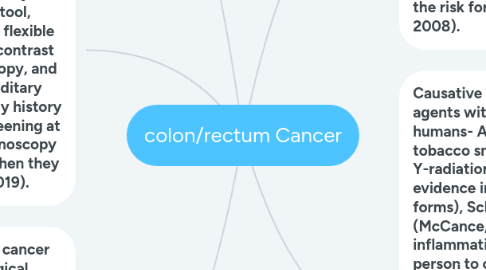colon/rectum Cancer
by Jen Rodriguez

1. Patho: Colon cancer is believed to arise from two types of precursor polyps via two distinct pathways: conventional adenomas by the conventional adenoma-to-carcinoma sequence and serrated adenomas according to the serrated adenoma-to-carcinoma theory. Conventional adenomas arise from mutation of the APC gene; progression to colon cancer is a multistep process. The fundamental genetic defect in serrated adenomas is unknown. Environmental factors can increase the risk for colon cancer (Cappell, 2008).
2. Causative factors: Carcinogenic agents with sufficient evidence in humans- Alcoholic beverages, tobacco smoking, X-radiation, Y-radiation; Agents with limited evidence in humans- Asbestos (all forms), Schistosoma japonicum (McCance, 2019). "Chronic inflammation predisposes a person to cancer in the GI tract, those whom have had UC for 10 years have a 30-fold increase of developing colon cancer; increased enzyme cyclooxygenase-2 (Cox-2), generate prostaglandins in acute inflammation (Strobehn, 2019). Bacterial infections like H. Pylori, chronic infections, peptic ulcer disease, stomach carcinoma, mucous associated lympoid tissue lymphomas bacteria can be both direct or indirectly produce genetic and epigenetic changes in infected stomachs (Strobehn, 2019).
3. Risk Factors: Some hyperplastic polyps are associated with colon cancer. Risk factors for malignancy in hyperplastic polyps include large polyp size (>1 cm diameter), location in the right colon, a focus of adenoma within the polyp (mixed hyperplastic-adenomatous polyp), more than 20 hyperplastic polyps in the colon, a family history of hyperplastic polyposis, and a family history of colon cancer (Cappell, 2008).
4. Diagnostic tests: Screening begins at age 50 for both men and women. Guaiac-based fecal occult blood test, fecal immunochemical test, yearly testing of spontaneous stool, stool DNA every 3 years, flexible sigmoidoscopy, double-contrast barium enema, colonoscopy, and CT. Individuals with hereditary polyposis or strong family history of CRC should begin screening at 10 to 12 years using colonoscopy and removal of polyps when they are found Huether, S. (2019).
5. Treatment: Treatment for cancer of the colon is always surgical, the location and amount of colon depend on the site of the cancer. Resection and anastomosis can be performed for early-stage tumors and are usually curative by way of laparoscopic or through abdominal incisions. Radiation therapy is given before surgery to shrink the tumor, adjuvant chemoradiotherapy is used to treat metastatic and cases with high risk of recurrence. Monoclonal antibody therapy and gene-specific may be added. Vaccines for colon cancers are still in clinical trials. Treatment for rectal cancers include preop chemoradiotherapy, total mesorectal excision, and adjuvant chemotherapy Huether, S. (2019).


